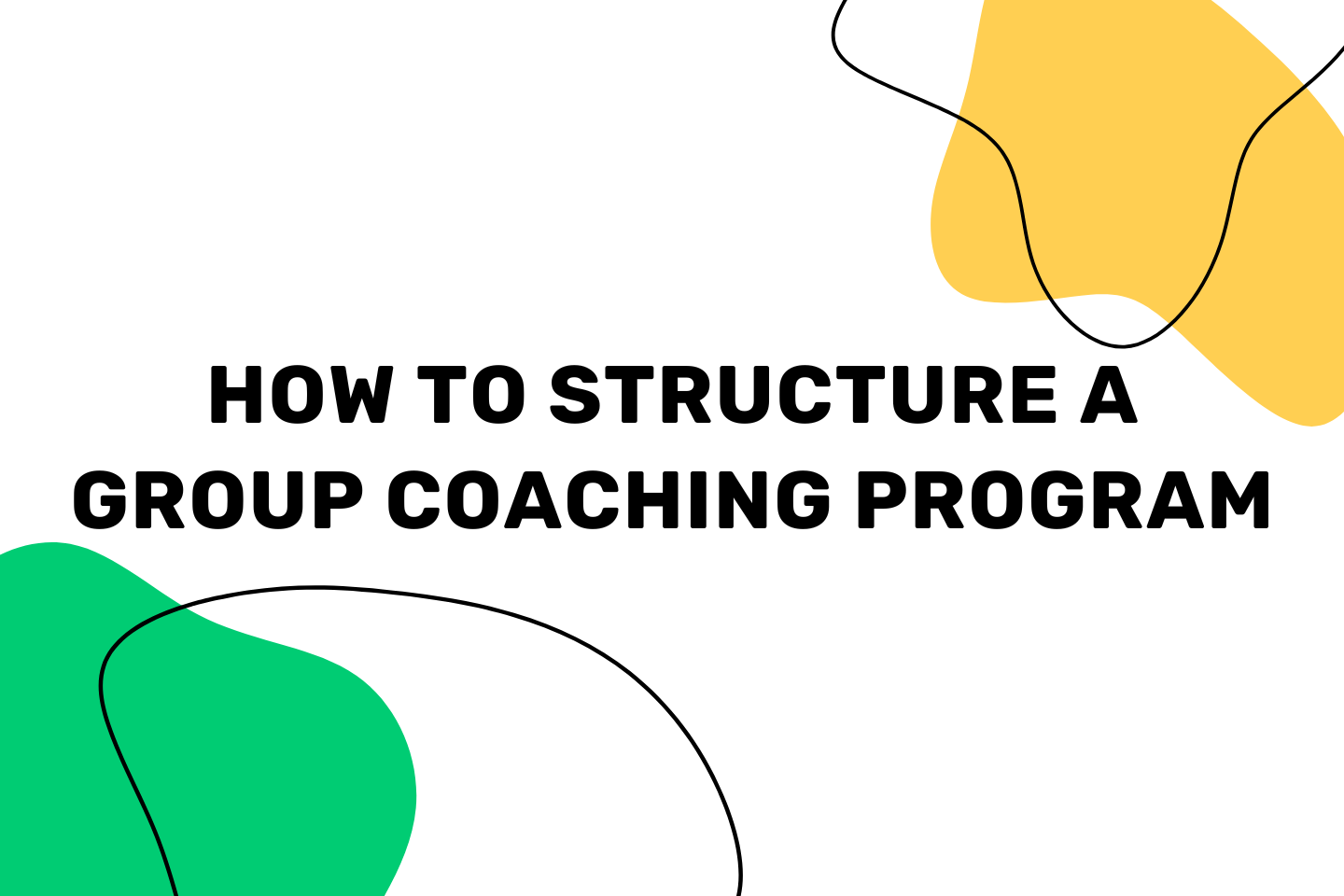Building out a group coaching program is a great way to impact more people, though using the same processes you use for one on one coaching in a group coaching program will lead to burnout and ultimately a poor user experience.
In fact, veteran coach Todd Herman has been there.
He has been coaching Olympic athletes and multi-million dollar business leaders for decades, and he also owns several six-figure group coaching businesses with NPS ratings of +33.
Therefore, I sat down with him to uncover the mechanics of building a successful group coaching program and the mistakes he made along the way.
Here is a step-by-step process you can use to design your own six-figure group coaching business.
Creating Your Material/Dialing in Your Offer
When coaching students one on one, it’s easy to meet the student where they are and tailor a program specific to their needs. However, this structure doesn’t scale very well as you can’t create custom material for each student in a group coaching program.
If you do try to scale it to cover every topic for every possible issue your student might have, the program will become bloated, and you’ll likely end up overworked and your students underserved as the program becomes overwhelming.
In fact, Todd mentioned that this was one of his biggest mistakes early in his group coaching career.
However, he found that the solution to this problem was to simply niche the offer down. By niching the offer down, he was able to cover the topic more thoroughly as there were fewer varied pain points across the group of students. In addition, the quality of the community increases as everyone is working towards a similar goal.
In addition, a niched offer usually requires less work on the back end as most of the questions will be similar, and the material will be so focused that it will likely already answer most of the questions your students have.
Therefore, rather than selling a course on leadership, consider niching it down to the subcategories of leadership, such as speaking skills, writing, on-stage skills, and networking. Even within each of these subcategories, there are more subcategories.
For example, rather than creating a writing leadership course, you could have a course on persuasion, storytelling, research papers, or even writing proposals to get public money funding.
As a result, you’ll notice that your student satisfaction and NPS scores increase as 100% of the material is relevant to all of your students. In fact, Todd’s course has a +33 NPS score thanks to this strategy.
In addition, you’ll be able to grow faster and take on more students like you and your coaches won’t be as tied up in answering student questions and offering additional support.
Therefore, look at the most common topics covered in your current coaching sessions and then choose one of those subtopics to create a course around.
Designing The Layout of Your Course
Once you’ve decided what you want to teach in your group coaching program, organizing the material in a cohesive manner is essential.
Specifically, all course materials should exist in one platform.
If you have your course spread out across multiple platforms, you’ll find that:
- Students have to remember multiple passwords, downgrading the experience.
- Students can’t find things and therefore tie up your time with support questions or arrive to meetings unprepared.
- Your assistant coaches may see a student has an issue, and two of them may jump on it without realizing the other one is already solving that issue.
- You’re paying for a lot of different software solutions, which gets expensive.
- Todd’s students have mentioned that having multiple platforms greatly reduced the overall experience of the coaching program.
Previously, Todd’s original course was structured like this:
- A variety of PDFs with notes and key concepts for reference
- Google docs to fill out to track progress (but when students saved it their own drive, the coaches could no longer track it)
- For some clients, they used Trello
- Thinkific housed the actual course material
- Facebook groups and Slack channels for community
Therefore, Todd was considering creating his own all-in-one platform before meeting upcoach’s cofounder, David Henzel. Designed as an all-in-one platform for group coaching, upcoach presents to-dos, tasks, assignments, meeting times, activity documents, communication, accountability, and more all in one location.
To this day, Todd uses upcoach for all of his group coaching programs and you can try out for yourself today.
Upcoach makes it much easier to track student progress, as the smart documents feature enables students to fill out activities and assignments within the platform. Though most importantly, it shows the coach exactly how much of the document they have filled out. This visibility helps coaches quickly identify where students are stuck and get them back on track, which improves completion rates and overall student satisfaction.

In addition to the smart documents feature, upcoach also hosts a robust student CRM that provides not only personal details and contact information, but also a detailed overview of completed to-dos and where they may be falling behind. Again, if you reach out to students the minute you see them struggling, overall course satisfaction will dramatically increase.

Onboarding Your Students
The next step to structuring a successful group coaching business is to onboard your students in a way that makes sense.
Todd emphasized the importance of this step multiple times, and it makes sense. Your students need time to get comfortable with the platform before you start asking them to complete tasks. Otherwise, they will be overwhelmed and give up.
For Todd’s 90 Day Year coaching platform, the onboarding process is about a week, and it includes basic tasks like filling out the profile, adding a profile picture, and then checking these items off the to-do list.
This way, it helps the person become familiar with the platform, and it also gets them into the right mindset for the course. For example, community is a huge reason why Todd’s courses have been so successful. Therefore, having them set up their profile, add a picture (which also gives them more of a sense of ownership), and connect with other people sets the students up for success.
In fact, Todd makes sure that the main course is blocked until they complete the onboarding steps.
Therefore, your onboarding process can be three, five, or seven days, though it should cover things like:
- Executing simple tasks and marking them off in the platform (to learn how to use the platform)
- Uploading a profile picture (this adds ownership)
- Filling out their bios (this sets the stage for community building
Organizing Meetings and Accountability
Once students enter the platform, a great group coaching program is designed for students to take action rather than passively consume information.
Therefore, while all of Todd’s courses had lesson videos, they were really only a catalyst for real action. For example, after completing a lesson, a new habit would be added to that person’s habit tracker to encourage action.
In addition to having assistant coaches monitor student progress, Todd also created accountability groups to help improve the course’s automation while maintaining quality. These groups can consist of 3-5 students, and they can meet weekly outside of the scheduled office hours to ensure each person is holding themselves accountable.
During these meetings, students can discuss how they are doing with their daily habits, and many of them will answer their own questions during this call.
However, Todd’s students also have group meetings with his coaches in addition to accountability meetings.
For his 90 Day Year course, students had scheduled meetings three times per week with coaches. They are structured like this:
- Monday: Call sets the priorities of the week. Students either state their priorities on the call live and fill them into upcoach, or just fill them into upcoach.
- Wednesday: This is the “get unstuck” call where people discuss challenges they are facing that week. Therefore, it’s more of a coaching call.
- Friday: This is a numbers call where people talk about their results for that week. As the program is getting small business entrepreneurs to look at their business with a data driven lens, this reinforces that idea.
Todd also runs a call on Thursdays with all groups and helps them with what they are struggling with. He also does a monthly call that focuses on strategy and support. So he might teach a certain topic and then stick around for two or three hours later to answer questions.
Scheduling all of these meetings is super easy as there is a meeting calendar directly inside the upcoach platform.
Implement Feedback and Continue Learning
Implementing the above structure will greatly improve your chances of creating a top-performing group coaching program. However, it’s important to realize that each group of students is slightly different, and collecting feedback and making adjustments is critical to growing any coaching program.
By improving your NPS score, you’ll not only impact the lives of more students, but they will also rave about it to their friends, which will become your most powerful marketing and sales weapon.
While most programs offer a general feedback survey at the end of the course, a hands-on course structure enables you to gather feedback throughout the course.
This will make the feedback more specific, and you might be able to make some adjustments to the course before students become frustrated with certain elements or quit.
Starting Your Group Coaching Program
If you’re ready to take action and get your group coaching program up and running, consider checking out the platform Todd uses for all of his courses, upcoach.
Designed to help coaches reduce administrative work, improve accountability, and provide a more premium customer experience, it is one of the easiest ways to set up your coaching program for success.
If you’d like to give it a try, sign up here, and we’ll give you a full refund if you don’t love it in the first 14 days.

